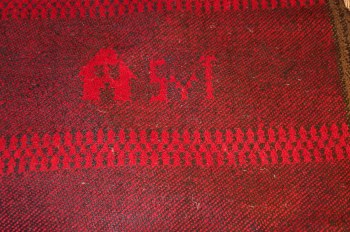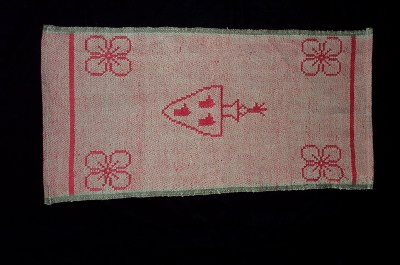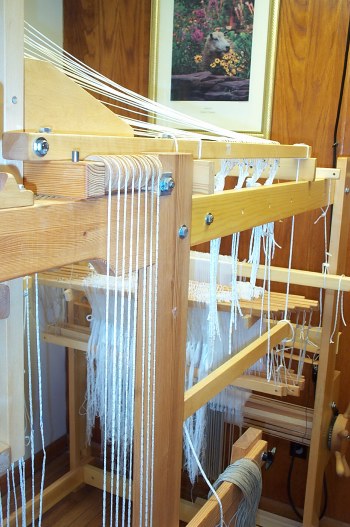| WOOLGATHERERS -Drawloom Weaving | |||||
|
How do you become interested in working with a drawloom? Weaving is most versatile on a generic loom - in my case, favoring 8-shaft traditional countermarche looms with overhead beaters. From simple rugs of thick handspun weft to the finest linens, it is only necessary to design a warp to work on the number of shafts and treadles available and then to weave it. Yes, there are limitations on the complexity, but that is offset by the wide range of fabrics and techniques that can be used without lots of modification. For a good 20 years, this was more than enough of a challenge. A few years back, I became interested in more complex weaves and began giving thought to the direction I'd like to go. Certainly the multi-shaft computer aided looms were interesting, but as with any device, had limitations as well. I followed the thread of many current articles in magazines and journals, used drafting software to work out designs for 16+ shafts, and just wasn't thrilled with the cloth these would produce. My notion of attractive fabric tends toward patterns with clean lines, limited color ranges, and a preference for designs that do NOT repeat selvage to selvage. Yet the total piece should have a certain symmetry and limited repetition. While rather old fashioned, a drawloom started becoming more and more attractive.
A drawloom - for a weaver, a wonderful and mystifying loom. For me, exploring the realm of drawloom weaving is similar to the 6 year old who takes piano lessons from the church organist, while dreaming of progressing to a pipe organ. The analogy is not far from the mark - weaving at its simplest involves a web of threads lying parallel, interlaced up-down, up-down with weft thread to form a cohesive piece of fabric. For speed and efficiency, shafts with heddles are added to lift and lower the warp and treadles added to those shafts so speed selection. The weaver learns to skillfully execute any number of patterns, use many shafts, integrate form and color into pleasing designs the way the piano student learns the technical skills of scales and exercises, advancing to pieces of increasing difficulty.
Then comes the day, when the student, of weaving or music, looks to a more advanced path - a path involving a more complicated instrument. In the 21st century, there are two tracks, if you will. One involves using emerging technology - a fully digitized keyboard instrument with built in stops and tonal shadings, recording abilities, - much the same as the new generation of multi-shaft computer controlled looms.
OR the decision can rest with the old idea of a pipe organ - manual, if you will, but an instrument rich in tradition, rich in sound, played with hands and feet. So is it with the drawloom. Much like the pipe organ, the feet are used to provide the rich undercurrent of bass (ground weave), while the hands prepare the tone structure by setting stops (simples, draw cords) prior to playing the keyboard.
Below are the first samples woven at Joanne Hall's studio in Clancy, Montana during a weekend course.
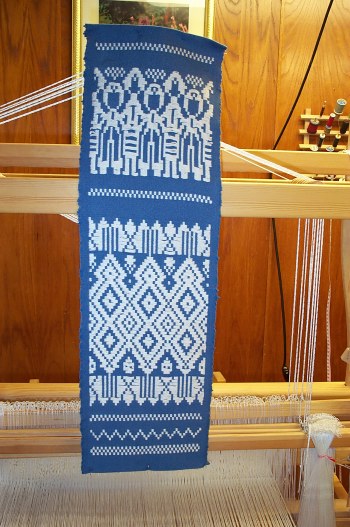 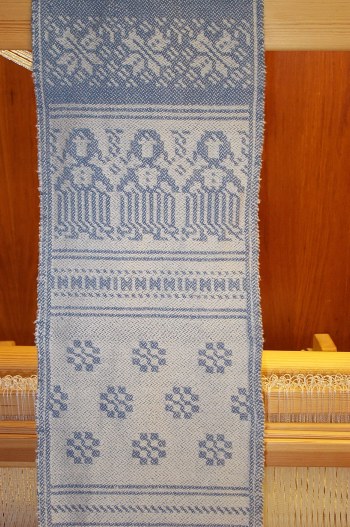 Left: Opphämta with 10-shaft draw device. Right: Damask woven onon the same warp - 10-shaft pattern device.
Left: Potential "signature" unit. Woven on single unit loom. Right: My husband's family crest surrounded by flowers. Also woven on single unit drawloom. |
 |
The basic loom - the Lilla (small footprint) vertical countermarche loom from Öxaback. 8-shafts, 8 treadles. 100cm weaving width. |
| The Myrrehed extension - custom made for my loom. The extension puts added distance between front and back to make room for the pattern shafts. |  |
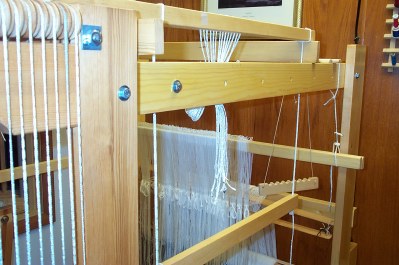 |
Building a drawloom requires that the loom be warped step by step during the construction of the drawbridge. Here is the loom with the warp beamed and threaded through the pattern heddles. Pattern heddles are first divided into groups corresponding to the number of threads in a pattern unit - in this case 6 - and each group weighted with a u-shaped weight or lingo. At this point, all pattern heddles are held on the heddling bar awaitin later distribution to the pattern shafts. Cords through the frame at top are from installing the pull cords and handles in the draw bridge. |
Front of loom at the same point.
Note that the countermarche jacks have been reversed so the short end now points upward - to avoid conflicts witn the draw bridge. |
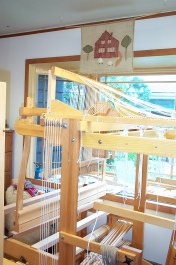 |
|
The next step is to move the ground shafts back near the pattern heddles, hang them in the shaft holders and thread them. This is accomplished by sitting inside the frame of the loom and sleying the heddles in a straight draw following the order of threading in the pattern heddles. Since the ground heddles have a 6cm eye they are easily threaded using only fingers. |
Here is the loom from the front showing the draw
cords and handles installed.
Now the ground shafts have been moved back into position just behind the beater, the reed has been sleyed (hanging just in front of the ground shafts BEFORE) they were moved forward. |
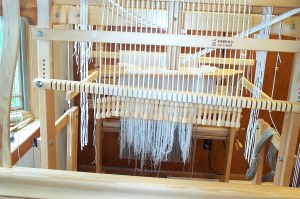 |
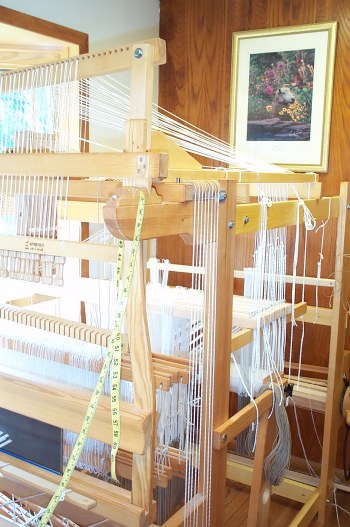 |
Then the pattern heddle groups were distributed on the 21 pattern shafts needed to complete this project. The pattern heddles are hanging on two
sticks supported from the loom frame and only move upward when one of the pull cords is activated. |
| Loom from the side, showing the arrangement of shafts weights and other loom parts. Tie-up is still not completed. | 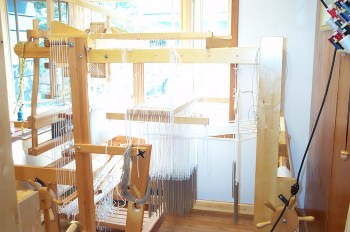 |
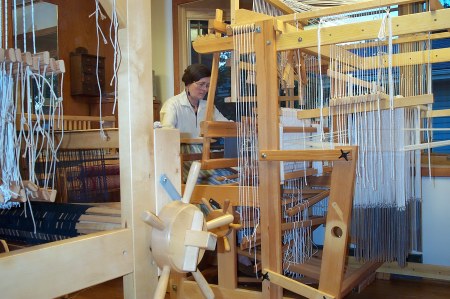
|
Sept. 6, 2004 - Labor Day - The loom is finally completed, warped AND IT IS WEAVING BEAUTIFUL CLOTH. First warp 900 ends of 20/2 cotton sett at 60 epi (24/cm) - weft 20/2 mercerized cotton, possibly other fine linen and
cotton threads to test how the fabric develops. Pattern threading - 21 shaft straight draw + x-shaft. Ground
fabric, 6-shaft satin. |
 |
Here you can see the pattern more clearly. Once the setup is complete, weaving is relatively easy and peaceful, though certainly not "fast". |
| 2005 - One year later | |
| Tthe drawloom has now been completely set up with all 50 pattern shafts. The pattern being woven is the sheep from our company logo to be used as "advertising" on our stand. | 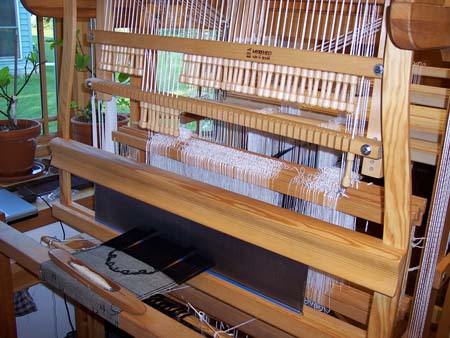 |
 |
The "console" of the loom as it appears to the weaver. Quite an array of "sticks and string" but once understood, it is a quiet and fascinating place to weaver. |
| The arch of cords from the comber board make a lovely display in their own right - loom seen from the side. | 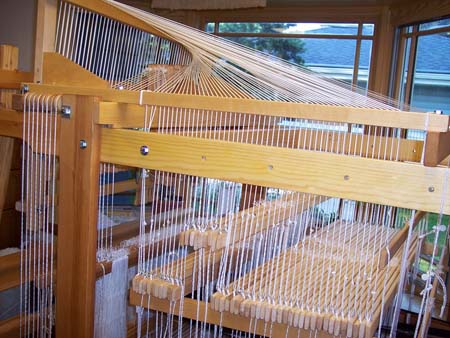 |

